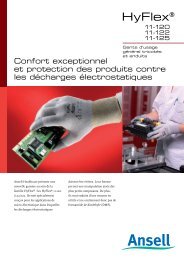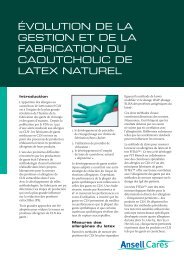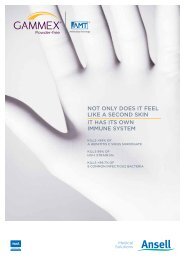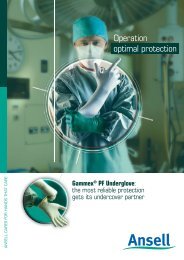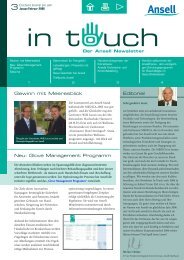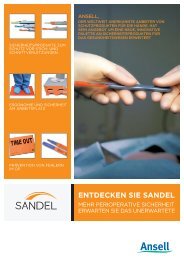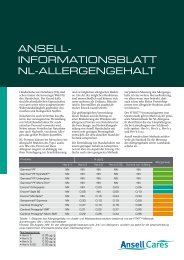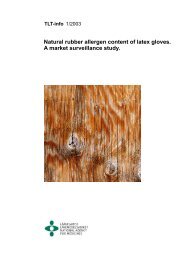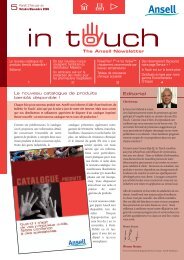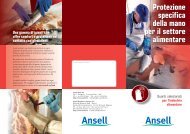Acceptable Quality Level (AQL) - Ansell Healthcare Europe
Acceptable Quality Level (AQL) - Ansell Healthcare Europe
Acceptable Quality Level (AQL) - Ansell Healthcare Europe
Create successful ePaper yourself
Turn your PDF publications into a flip-book with our unique Google optimized e-Paper software.
<strong>Acceptable</strong> <strong>Quality</strong> <strong>Level</strong><br />
(<strong>AQL</strong>)<br />
<strong>Acceptable</strong> <strong>Quality</strong> <strong>Level</strong> (<strong>AQL</strong>) is a statistical<br />
measure of the consistency or quality predictor of<br />
manufactured goods. It applies to all batch type<br />
production as a means of ensuring that the process<br />
average meets the standards determined. For<br />
medical products, it is critical that the products are<br />
manufactured to a very high standard at all times.<br />
Surgical and examination gloves are essential barrier<br />
protection items and neither you nor your patients<br />
want to receive a defective glove, however very rarely<br />
this may occur.<br />
What is a homogeneous<br />
batch?<br />
The term homogeneous batch refers to products<br />
that are made in groups and from the exact same<br />
parameters. Gloves, for example, would be from such<br />
a batch if the latex used, production settings and<br />
finishing processes are all exactly the same over that<br />
period. Any alteration at any stage of production is<br />
considered a new batch.<br />
Process average<br />
This term refers to the manufacturing process’<br />
average defect or reject rate. It is critical as an<br />
indicator of the manufacturing quality. To assess this<br />
a set number of gloves taken from the production<br />
line every two minutes are subjected to a full range of<br />
quality tests. The reject rate is the failure percentage<br />
of the product. Production processes are kept in tight<br />
tolerances with the use of control charts.<br />
Control charts<br />
These charts are like recipe cards and they outline all<br />
the parameters for the product being manufactured.<br />
In the case of <strong>Ansell</strong> gloves, for example, they would<br />
contain the latex and chemical mix for the dip, the<br />
production speed, oven temperatures, type of former<br />
to be used and every parameter including the post<br />
production processing. The tighter the parameters or<br />
tolerances in the control chart, the more consistent<br />
the quality of production will be. Every manufacturing<br />
step of an <strong>Ansell</strong> glove is documented and mapped<br />
for the production process to ensure our gloves are of<br />
the highest possible standards.<br />
<strong>AQL</strong> sampling<br />
The table on the reverse is an example of the<br />
arbitrary statistical system for <strong>AQL</strong> testing. You will<br />
see that inspection levels are set at ‘<strong>Level</strong> I’. This<br />
is the industry standard for medical grade quality<br />
inspection. Variance to another inspection level e.g.<br />
for machinery, would prescribe different tolerance<br />
levels. The variable parameters are:<br />
1. The lot/batch size.<br />
2. The inspection level – determined by<br />
AS/NZS4079:1997 and 4011:1997 at level I.<br />
3. <strong>AQL</strong> level determined.<br />
Depending on these points, the number of allowable<br />
failures per sample test will determine the arbitrary<br />
‘yes’ or ‘no’ for that batch to statistically pass the <strong>AQL</strong><br />
standard. Failure will mean that the manufacturer has<br />
to inspect every piece of the batch to remove defective<br />
products. This is time consuming and expensive.<br />
Therefore, it is better to build the quality assurance<br />
system into the production process rather than use<br />
inspection at a later stage to remove defects which<br />
occur through inexact production processes.
Curve number <strong>Ansell</strong> 2 3 World standard 5<br />
<strong>AQL</strong> 0.065 0.9 1.1 1.5 2.5<br />
Inspection level II II II II II<br />
Lot/batch size 10,000 10,000 10,000 10,000 10,000<br />
Sample size 200 200 200 200 200<br />
Acceptance number 0 3 5 7 10<br />
Curves for Sampling Plan<br />
Probability<br />
of<br />
Acceptance<br />
1.200000<br />
1.000000<br />
0.800000<br />
0.600000<br />
0.400000<br />
0.200000<br />
0.000000<br />
0 0.5 1 1.5 2 2.5 3 3.5 4 4.5 5 5.5 6 6.5 7 7.5 8 8.5 9 9.5 10 10.5 11 11.5 12<br />
You can see in the graph that the lot (batch) size and<br />
inspection level are the same and only the <strong>AQL</strong> level<br />
varies. At an <strong>AQL</strong> of 2.5 the acceptable number of<br />
defects in the sample lot is 10. This falls to 7 allowable<br />
defects at an <strong>AQL</strong> of 1.5 (the world surgical glove<br />
standard). <strong>Ansell</strong>’s <strong>AQL</strong> level of 0.065 (before packaging)<br />
means that a single defect in the sample lot will result<br />
in an <strong>AQL</strong> failure, resulting in every glove in the<br />
production batch being inspected. As previously stated,<br />
this is time consuming and expensive. Setting an <strong>AQL</strong><br />
so low is only possible if the quality and consistency of<br />
production is very high and tightly controlled.<br />
An <strong>AQL</strong> test is an absolute test i.e. ‘yes’ it passes or<br />
‘no’ the batch cannot be released. However the <strong>AQL</strong><br />
test is a direct reflection on the manufacturing process<br />
quality and conformity. <strong>Ansell</strong>’s <strong>AQL</strong> level of 0.065<br />
Percent Defective<br />
<strong>AQL</strong> 0.065 INSP-II <strong>AQL</strong> 0.9 INSP-II <strong>AQL</strong> 1.1 INSP-II <strong>AQL</strong> 1.5 INSP-II <strong>AQL</strong> 2.5 INSP-II<br />
<strong>Ansell</strong> <strong>Healthcare</strong> <strong>Europe</strong> N.V.<br />
Riverside Business Park, Spey House, Boulevard International 55, B-1070 Brussels, Belgium<br />
Tel. +32 (0) 2 528 74 00 Fax +32 (0) 2 528 74 01 Fax Customer Service +32 (2) 528 74 03<br />
http://www.anselleurope.com E-mail info@eu.ansell.com<br />
(before packaging) ensures that you will consistently be<br />
assured of the highest quality barrier protection. There is<br />
however, as with everything a very rare occasion when a<br />
glove may be defective.<br />
What is the <strong>AQL</strong> level of the<br />
gloves you are using now?<br />
<strong>Ansell</strong>’s <strong>AQL</strong> standards:<br />
• Surgical gloves is 0.065 before packaging<br />
(World standard 1.5).<br />
• Examination gloves 1.5 (World standard 2.5).<br />
Be <strong>Ansell</strong> Sure.



